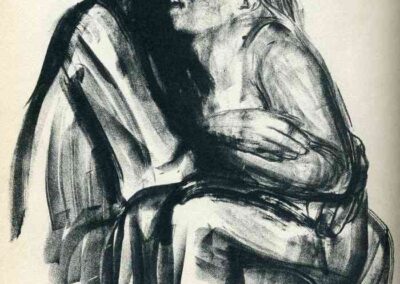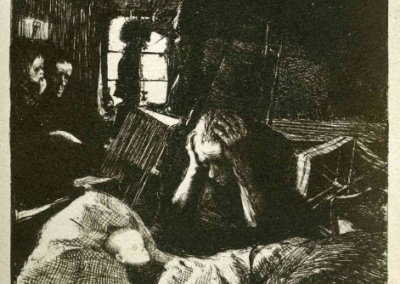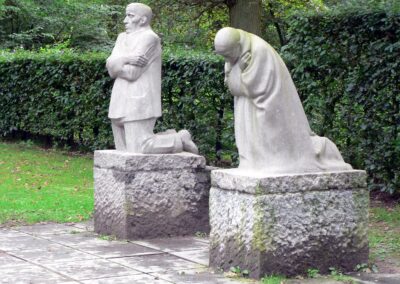In 2018, the Art Gallery of Ontario (AGO) devoted several spaces, over six months, to the very evocative, and still incredibly moving (after nearly a century) works of our latest Artist You Need To Know. Käthe Kollwitz‘s practice – which was an unflinching record of the world around her, but always an impressive melding of technique and emotion – stretched over more than five decades: “Kollwitz developed powerful and emotional imagery based on her own experiences, her interactions with working-class women in Berlin, and her exposure to the horrors of two world wars….In addition to her self-portraits, themes in Kollwitz’s work examine the lives and suffering of poor women, the intimate relationships between mothers and children, humanitarian and social issues, and her ongoing dialogue with death. Kollwitz designed prints and posters to protest poverty, hunger, and child mortality.” (from the AGO)
Kollwitz was very aware of her role, and her voice, during a time of nearly unparalleled change. From her diary, in 1920: “I felt that I have no right to withdraw from the responsibility of being an advocate. It is my duty to voice the sufferings of people, the sufferings that never end and are as big as mountains.”
The empathetic, political nature of her work also made her a target. When the Nazi regime came to power in Germany in 1933, she was ousted from the faculty of the Akadmie der Künste and her artwork removed from museums. In 1936, the Gestapo threatened her with arrest and incarceration in a concentration camp: Kollwitz – always defiant in the face of injustice – had intended, with her husband, to commit suicide if this came to pass. However, the respect and admiration she’d attained internationally stymied the Fascists, and no action was taken.
Kollwitz was born in what is now Kalingrad, Russia, and “her name evokes images of bereaved mothers, ailing, fatherless children, anguished parents, and, more generally, suffering and death. However, her reputation, while largely defined by its socially critical subject matter, also rests on her artistic talent and drive for experimentation in a wide range of mediums.” (Luise Mahler, writing for MoMA The Museum of Modern Art)
Kollwitz’ best known series are The Weavers and The Peasant War, documenting “the effects of poverty, hunger and war on the working class. Despite the realism of her early works, her art is now more closely associated with Expressionism. Kollwitz was the first woman to not only be elected to the Prussian Academy of Arts but to also receive honorary professor status.” (Wikipedia)
The legacy of Käthe Kollwitz almost a century after her death in 1945 is undeniable. In Germany alone, over forty schools bear her name. Four museums in Germany (including Käthe Kollwitz Museum Köln and Käthe-Kollwitz-Museum Berlin) are dedicated to her work. As well, the Käthe Kollwitz Prize (established in 1960) is presented annually to a contemporary artist who resides in Germany.
-

Käthe Kollwitz, The Grieving Parents, 1932
-

Käthe Kollwitz, The Grieving Parents, 1932, back view
-

Portrait of a Working Woman with Blue Shawl, 1903
Her archive is extensive (especially as she favoured prints, to better disseminate her ideas, and raise awareness), so what we’re sharing is only a sample. But there’s significant information about her online, that a simple search will bring to you: this is fitting, as Kollwitz was focused upon art that could be widely seen, and was instrumental in shaping what we now know as social protest art.












